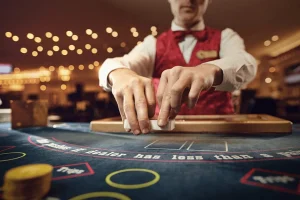
The Role of the Dealer’s Up Card in Blackjack Strategy
Blackjack is an engaging casino game that combines strategy and skill into an immersive experience. To play successfully, one must make the optimal decisions (hit, stand, double down, or split) based on his/her hand and dealer’s upcard – with charts available that help provide guidance for optimal decisions depending on which rule set they’re using.
Basic strategy
Basic strategy is the mathematically optimal way of playing blackjack hands, taking into account player decisions and the dealer’s up card. When used consistently, basic strategy can significantly lower or even eliminate the house edge in certain circumstances – estimates provided by casinos or gaming regulators assume players use basic strategy when they discuss house edges for blackjack games.
Decisions taken by players should depend on both the dealer’s up card and their hand count. Some dealer up cards increase or decrease player advantage; by studying probabilities in each situation you can create favorable situations for yourself.
To practice making correct playing decisions, you can use a deck of cards and deal yourself two hands while the dealer turns over an up card. Compare your decisions against a strategy chart to ensure that you are using the appropriate strategy – don’t give up too quickly if things slip your mind! Practice makes perfect!
Insurance bets
No matter their experience or skill level in blackjack, players should pay careful attention to the dealer’s up card in order to make informed decisions in every round. Though insurance bets offer 2-1 odds when an ace appears as the dealer card, their return often doesn’t justify their cost in most instances.
As soon as a dealer shows an up card, they will ask all players whether or not they would like to place an insurance bet. Those who accept will place a side bet equaling half their original bet that pays out 2:1 odds that the dealer has blackjack. When all of the players accept an insurance bet, then after peeking under their second card the dealer will acknowledge any hands that qualify as pushes for blackjack before dealing out another hand.
Dealer’s up card
The dealer’s up card is an important factor when playing blackjack. It reveals their card value, which may affect whether they hit, stand, double down or split their hand. Furthermore, it helps players anticipate which cards might give the dealer an automatic 21 when looking at their hand or waving palm-down over the betting area. To see it themselves they can simply look down or wave their hands in front of themselves or wave palms down over betting area to view this card from above.
The dealer’s up card can have a significant effect on player strategies and decisions to hit, stand, or double down. For instance, when dealing with fours (dealer upcard) they tend to bust more often. Players can adjust their strategy based on this knowledge in order to improve their odds of victory. A dealer must hit until reaching 17 or higher; their upcard may affect whether they should hit or double down; weak upcards usually lead them to hit while strong ones will cause them to stay put.
Dealer’s down card
Blackjack is an exciting casino game requiring skill, strategy, and some luck. Each hand begins when a dealer hands out one card to each player. At that point, each player decides if they wish to hit (take another card), stand (keep their cards), double up or split their cards; when their total surpasses that of the dealer they win; otherwise they bust and automatically lose.
Understanding what the dealer has revealed can assist in making better decisions when playing blackjack, and increase your odds of success by taking advantage of advantageous situations.
If the dealer displays low up cards such as 2, 3, 4, 5 or 6, it is generally wise to hit. Doing so increases your odds of landing a blackjack, which pays 2:1; however, insurance or even money bets should be avoided in such cases.



Average Rating